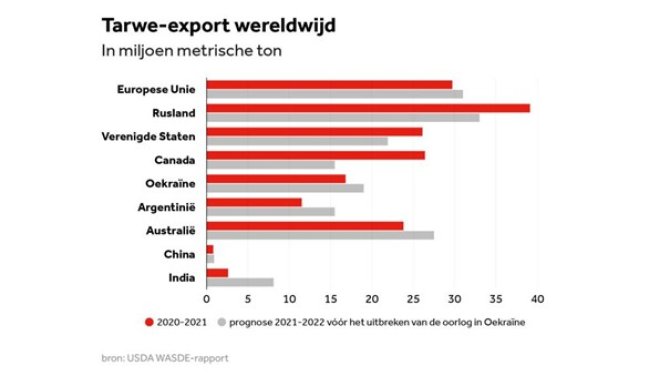The war in Ukraine has a major impact on the availability and price of wheat across the world. We talked about this in the national Dutch newspaper "De Financiële Telegraaf". Now that an agreement in principle is being made between Ukraine and Russia on the passage of the grain across the Black Sea, major issues remain when it comes to the safety of the grain ships. For example, who is going to send the 300 ships of grain and can these ships still be insured?
In the meantime, the wheat is still waiting in the silos while the next harvest is already on its way. People are talking about a food crisis, but is this the right term? It is more of a food-price crisis, and some parties have earned a lot of money from it. What is this market like now? We investigate this by exploring seven questions.
1. Is there enough wheat in the world to feed everyone?
In principle, there is still enough wheat for the whole world. The spike in wheat prices and the blockade on relatively cheap wheat from Ukraine are causing the problems. Ukraine is by no means the biggest wheat producer in the world. The biggest wheat producers are China and India, but they mainly produce wheat for domestic consumption. Ukraine does have an important place on the list of the biggest grain exporters (although Russia, the US, the European Union, and Australia are at the top), and much of that wheat and maize cannot currently leave the country. Exports from Russia have also largely come to a standstill. Ukrainian and Russian wheat in particular dominated exports to the Middle East and North Africa, with relatively short transport routes. The importing countries are now dependent on other, much more expensive supplies.

The current problem for Ukrainian exporters is that they cannot get rid of their wheat due to the blockades and mines at the ports that are still in Ukrainian hands. At the same time, the next harvest is coming. The Ukrainian farmers and exporters are therefore forced to lower their price for the wheat that they have in their storehouse, but that does not help exports. With this as the status quo, wheat prices on international markets remain high.
Due to the much higher wheat price on the world market, importers also need more trading capital to buy wheat and ship it to their domestic markets. Often importers in certain countries (often in Africa) do not have sufficient trading capital to finance wheat transactions. This leads to absolute shortages on those national markets and further drives up the domestic price of wheat.
The winter harvests of wheat are now arriving in various countries, including Russia and the US. These harvests are better than expected and will bring the world market price for wheat down drastically again.
In short, there is enough wheat in the world in principle to feed everyone. However, the much higher price hinders consumers with low purchasing power from getting to that wheat. Locally, absolute shortages can arise due to a lack of trading capital among importing firms. New crops from countries other than Ukraine can make up for the shortage and bring down and stabilise the world market price for wheat.
2. How does the world grain trade work?
After the harvest, most wheat ends up with a handful of buyers: a list of global traders that has shrunk from a few dozen to four dominant multinationals after mergers in recent decades. These multinationals are collectively referred to as ABCD: ADM, Bunge, Cargill, and Louis Dreyfus. They are not well known because they mainly deal in bulk goods and make products such as fodder, corn syrup, or flour - not exactly something you'd see in eye-catching ad campaigns. However, these companies are powerful. Cargill is the seventh largest food giant in the world, after companies such as Nestlé, Pepsi, Coca-Cola, Philip Morris and Unilever.
The four multinationals trade more than 70 percent of the grain and resell it to the highest bidder. They dominate the grain market and can take advantage of price differences that arise between exporting and importing countries. With their large storage, processing, and logistics facilities, they can quickly respond to shortages. It has not been demonstrated whether they also create shortages in order to benefit from rising prices or whether they make price agreements among themselves.






